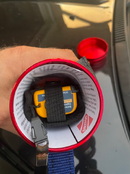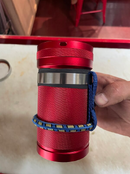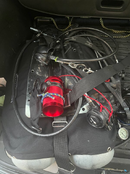tmassey
Contributor
This is a review of the DryFob XL (https://dryfob.com/product/dryfob-xl-waterproof-plb-container/), a waterproof canister designed to keep items dry down to 100 meters or beyond, sized to contain PLB's and other such items of similar size.
This is somewhat long (surprise!). I start with a brief description of what I'm using it for, and other solutions I've tried. I've put subheadings in, so feel free to skip to the review details in the second post.
Why Is This Needed?
For many, a Personal Locator Beacon (PLB: Emergency position-indicating radiobeacon - Wikipedia ) is a desirable part of their SCUBA emergency equipment. The majority of these devices combine a GPS with a radio transmitter designed to communicate with satellites in orbit anywhere in the world. For me, I acquired a PLB before I went on a liveaboard in Egypt: it is not unknown for such liveaboards to sink. But even in the United States, it's not unknown for divers to end up floating at sea, so once having spent the money, it would be very useful to be able to have my PLB with me.
The problem is, these devices are not designed for SCUBA divers. Even the best of them are only waterproof to about 30 feet, and most are 15 feet or less -- more splashproof than waterproof. There is one such device (the Nautilus: Nautilus Marine Rescue GPS - Free to use, Diver Rated to 425 ft. | Nautilus LifeLine ) that is rated to below 100 meters, but it works differently: it sends signals to a nearby boat in line of sight, rather than satellites in orbit). There are advantages and disadvantages to each. This review isn't about PLB's themselves; but suffice it to say that for many people, the satellite-based EPIRB PLB better fits their needs. But they're only barely waterproof.
So if you want to carry such a PLB, you need a way of protecting it while you're deep underwater. After all, the most likely time to need a PLB is when you come up from a dive and the boat is nowhere to be seen. If you can't bring it with you throughout the dive, it rather defeats the purpose of having it in the first place: it does you no good if it's left behind on the boat while you do the dive. So how do you accomplish that?
Bad Idea: Cell phone bag
My solution for this was simple: use a flexible drybag designed for cell phones. This seemed like a decent solution: it was cheap, it was designed to keep water out of sensitive electronics, and even if it didn't work perfectly, the PLB itself was waterproof enough to keep water out even if the bag leaked a bit. So why not?
One kind of obvious thing was that the water would be pressing in on the device through the plastic bag. Could that activate the button? It seemed like this would be unlikely: the PLB I use, an OceanSignal PLB1) has a protective cover over the button, as well as a neoprene cover over the entire device (to make it float), wich seemed like it would be enough protection.
So, that's what I did. But this did not work well, and in the end, it did not work at all. First, the cases are designed for wide, flat things -- cell phones. Sticking a bulky, chunky object them was not a great fit. The hard plastic top meant it was going to take a bunch of width anyway, and now it was going to take a bunch of depth, too. This made it pretty awkward in a diving pocket. In addition, the shape also put a bunch of stress on the bag in ways it wasn't designed to. Which meant it leaked pretty quickly. The PLB is designed for that, but still not optimal.
But these were not what made it a failure. What made it a failure was the time I got off a dive boat after a couple of very nice dives, leisurely put all my stuff in the car, and then checked my cell phone -- and found a half-dozen voicemail and texts from the Coast Guard! I immediately called them (but like 90 minutes or more after the messages started) to let them know that I was fine, and they told me that the helicopter was just taking off to come find me... Seems the pressure pressed the button unbeknownst to me. Huge pluses to the Coast Guard for coming to get me, and to my PLB1 getting a signal out even with the antenna stowed; but huge minuses for me to ask them to come get me when I didn't need to be.
So I haven't carried my PLB with me since then.
Until now.
Good Idea: DryFob XL
When I originally went looking for ways to protect my PLB, the only solutions I could find were either soft bags or battery pack canisters. The soft bags had the very strong advantage of cost and size; the battery canisters had the opposite disadvantages. They were very large (if you re-used an old one), or very expensive (as in $250 or more, if you had one made to a reasonable size). Which is why I went with the cell bag.
However, sometime later, @Jaan appeared with an intriguing possibility: the DryFob. This was exactly what I wanted: a small and affordable (dirt cheap, really) canister that did exactly one thing: kept its contents dry during a dive. It was very nearly perfect, except for one thing: it was too small. It was designed for keyfobs, and even the largest keyfobs are quite a bit smaller than a PLB.
But I messaged him way back in May, 2021 and mentioned PLB's, and how there were quite a few of us that had them and needed a way to take them on a dive. Of course, there aren't as many PLB's as keyfobs... but could there be enough that it would be worth a larger model?
Fast forward a year, and today we have it: the DryFob XL. It's exactly what I described: a small canister with one job: keep its contents dry during a dive. No extra holes or purposes (like either a cell phone bag or light canister), just a dry "box", but this time sized for a PLB! Yes, please.
So I purchased one (actually, two, to get free shipping). I received it a couple weeks ago, and I've had it on a few dives now, so now I can write up a review.
This is somewhat long (surprise!). I start with a brief description of what I'm using it for, and other solutions I've tried. I've put subheadings in, so feel free to skip to the review details in the second post.
Why Is This Needed?
For many, a Personal Locator Beacon (PLB: Emergency position-indicating radiobeacon - Wikipedia ) is a desirable part of their SCUBA emergency equipment. The majority of these devices combine a GPS with a radio transmitter designed to communicate with satellites in orbit anywhere in the world. For me, I acquired a PLB before I went on a liveaboard in Egypt: it is not unknown for such liveaboards to sink. But even in the United States, it's not unknown for divers to end up floating at sea, so once having spent the money, it would be very useful to be able to have my PLB with me.
The problem is, these devices are not designed for SCUBA divers. Even the best of them are only waterproof to about 30 feet, and most are 15 feet or less -- more splashproof than waterproof. There is one such device (the Nautilus: Nautilus Marine Rescue GPS - Free to use, Diver Rated to 425 ft. | Nautilus LifeLine ) that is rated to below 100 meters, but it works differently: it sends signals to a nearby boat in line of sight, rather than satellites in orbit). There are advantages and disadvantages to each. This review isn't about PLB's themselves; but suffice it to say that for many people, the satellite-based EPIRB PLB better fits their needs. But they're only barely waterproof.
So if you want to carry such a PLB, you need a way of protecting it while you're deep underwater. After all, the most likely time to need a PLB is when you come up from a dive and the boat is nowhere to be seen. If you can't bring it with you throughout the dive, it rather defeats the purpose of having it in the first place: it does you no good if it's left behind on the boat while you do the dive. So how do you accomplish that?
Bad Idea: Cell phone bag
My solution for this was simple: use a flexible drybag designed for cell phones. This seemed like a decent solution: it was cheap, it was designed to keep water out of sensitive electronics, and even if it didn't work perfectly, the PLB itself was waterproof enough to keep water out even if the bag leaked a bit. So why not?
One kind of obvious thing was that the water would be pressing in on the device through the plastic bag. Could that activate the button? It seemed like this would be unlikely: the PLB I use, an OceanSignal PLB1) has a protective cover over the button, as well as a neoprene cover over the entire device (to make it float), wich seemed like it would be enough protection.
So, that's what I did. But this did not work well, and in the end, it did not work at all. First, the cases are designed for wide, flat things -- cell phones. Sticking a bulky, chunky object them was not a great fit. The hard plastic top meant it was going to take a bunch of width anyway, and now it was going to take a bunch of depth, too. This made it pretty awkward in a diving pocket. In addition, the shape also put a bunch of stress on the bag in ways it wasn't designed to. Which meant it leaked pretty quickly. The PLB is designed for that, but still not optimal.
But these were not what made it a failure. What made it a failure was the time I got off a dive boat after a couple of very nice dives, leisurely put all my stuff in the car, and then checked my cell phone -- and found a half-dozen voicemail and texts from the Coast Guard! I immediately called them (but like 90 minutes or more after the messages started) to let them know that I was fine, and they told me that the helicopter was just taking off to come find me... Seems the pressure pressed the button unbeknownst to me. Huge pluses to the Coast Guard for coming to get me, and to my PLB1 getting a signal out even with the antenna stowed; but huge minuses for me to ask them to come get me when I didn't need to be.
So I haven't carried my PLB with me since then.
Until now.
Good Idea: DryFob XL
When I originally went looking for ways to protect my PLB, the only solutions I could find were either soft bags or battery pack canisters. The soft bags had the very strong advantage of cost and size; the battery canisters had the opposite disadvantages. They were very large (if you re-used an old one), or very expensive (as in $250 or more, if you had one made to a reasonable size). Which is why I went with the cell bag.
However, sometime later, @Jaan appeared with an intriguing possibility: the DryFob. This was exactly what I wanted: a small and affordable (dirt cheap, really) canister that did exactly one thing: kept its contents dry during a dive. It was very nearly perfect, except for one thing: it was too small. It was designed for keyfobs, and even the largest keyfobs are quite a bit smaller than a PLB.
But I messaged him way back in May, 2021 and mentioned PLB's, and how there were quite a few of us that had them and needed a way to take them on a dive. Of course, there aren't as many PLB's as keyfobs... but could there be enough that it would be worth a larger model?
Fast forward a year, and today we have it: the DryFob XL. It's exactly what I described: a small canister with one job: keep its contents dry during a dive. No extra holes or purposes (like either a cell phone bag or light canister), just a dry "box", but this time sized for a PLB! Yes, please.
So I purchased one (actually, two, to get free shipping). I received it a couple weeks ago, and I've had it on a few dives now, so now I can write up a review.
Continued in the next post






